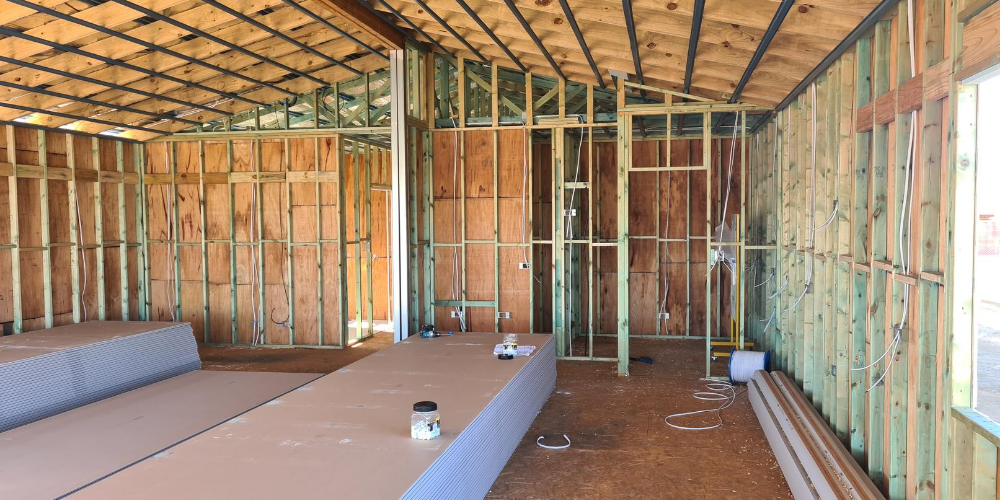What Are Modular Homes Made Of?
Many people assume that the trend of modular construction has only been around for a few decades at most, but this type of construction is far from new. Modular or prefabricated construction has been around for thousands of years and is still evolving today.
A quick history of modular construction
A few centuries ago, Ancient Romans quickly built forts by tilting panels into place that were pre-made using wooden frames filled with stone and mortar. A few thousand years later, the pieces of the Eiffel Tower were drilled, shaped, and constructed in an offsite factory located on the outskirts of Paris. The prefabricated parts were then shipped onsite where it was assembled in the record time of just over two years and two months.

But the concept of prefabricated design and construction wasn’t only used for ancient wars and French sculpture. The first documented residential application was an early US settler in Massachusetts who arranged a panelised wood house to be shipped from England in 1624.
Closer to home, some Australian cottages in the early 1800s were pre-manufactured before being shipped and put together onsite. This created a precedent for modular home construction for many years to come, especially during tough financial times and surging population growth.
In more recent years, modular construction has become increasingly prominent for one main reason – convenience!
How are modular homes made today?
Because modular homes are made in sections in factories, they are often called 'prefabricated homes' or 'factory-built' homes. This factory process allows modular home manufacturers to build in a protected and climate-controlled environment, away from the elements which can otherwise affect building materials and construction timeframes.
Once the modular home is ready, it is transported by flatbed truck to site, where it will be set on a traditional foundation and then assembled according to the predetermined plans. Modular homes that are fully assembled and installed on foundations look like any other house. And just like any traditionally constructed building, a modular home must also adhere to all local building codes, so it must be structurally inspected before moving in.
So, what are modular homes actually built from?
While not all modular homes are built using the same materials, you can be sure that they all use the same high quality, durable materials that are used by conventional builders. That being said, the most common building materials used in modular construction include wood, concrete, and steel.
Wood
Because it is lightweight, durable and can support its weight better than materials like steel, wood is a common material used in modular construction. It is ideally suited because it has excellent sound-absorption properties and is also naturally resistant to electricity.

Concrete
Often seen in a variety of currently popular modular constructions, concrete is a robust material that provides both thermal insulation as well as optimum acoustics. The superior strength and durability of concrete allows it to withstand almost anything, from cyclones to floods.
Structural Steel
Typical steel construction uses steel framing with a steel and concrete base and wall panels made from cold form steel. Steel construction permits larger span openings between beams than wood, which means there are less raw materials required. Because it is a fire-resistant material, building with steel allows for buildings with increased footprints and heights. Also, each piece of steel will be consistently the same as the next, whereas wood often contains naturally occurring variations.
The future of housing
Given today’s constantly rising costs and environmental concerns, the traditional model of building housing is changing. Often referred to as 'the future of housing', modular construction has seen a sharp increase in interest and popularity, especially over the last decade or so, thanks to all the alluring possibilities it has to offer.
Compared to conventional house construction, modular homes usually cost less, are more sustainable and take much less time to finish building. There are also the added advantages of less wastage during the prefabrication stage of a modular home inside a factory, which also means bad weather never stops work.
Whatever the future of building is in Australia, it is highly likely that stylish and well-built modular homes have officially moved in and are here to stay.
Could a modular home be right for you?
If you think that building a new modular home might be the best option for you, and you’re interested in a more cost-effective and streamlined construction process, talk to the team at Westbuilt Homes.
We have been designing and building stunning modular homes since 1993. The construction process of a modular home is very different to that of a conventional home, giving you greater control over the construction time, the quality and the timeframe.
To learn more about modular construction, click here to book a no obligation consultation with one of our modular experts. We’d be happy to answer any questions you may have.

-1.png?width=352&name=3-x-modern-modular-homes%20(1)-1.png)

